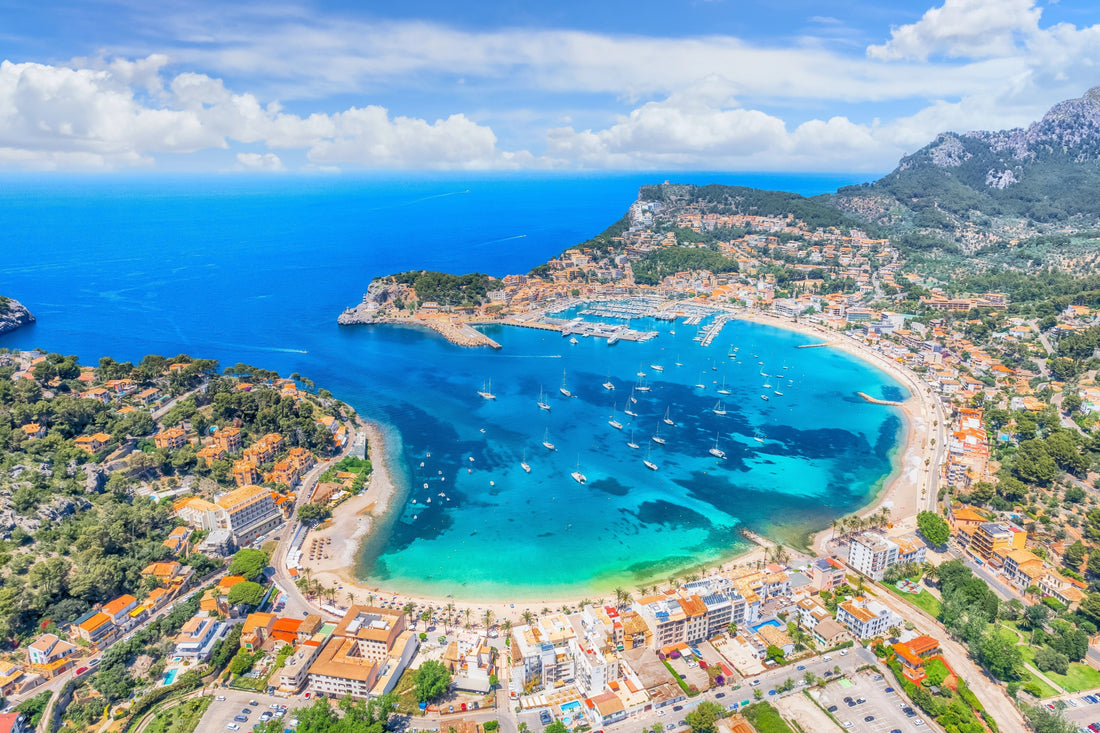
Mallorca, Spain Travel Guide: Best Beaches, Villages and Day Trips
Mallorca is the Mediterranean dream come to life, a sun-kissed island where turquoise coves meet golden cliffs, and time seems to slow in stone-paved mountain villages. From the craggy, wild beauty of the Tramuntana Mountains to the calm, crystal-clear waters of the southeast, every corner of Mallorca feels like a new discovery. Spend your days hopping between secluded calas with glowing blue water, wandering through storybook towns like Valldemossa and Deià, or following winding coastal roads that open to views you’ll never forget. Whether you’re here for lazy beach days, cliff-jumping adventures, or long lunches by the sea, this island will win you over instantly.
Here’s your complete travel guide to Mallorca, from the best beaches and hidden coves to the most charming villages and must-see sights that make this Balearic gem so unforgettable.

Mallorca, panoramic view of the island with rolling hills, turquoise coastline, and terracotta-roofed villages under the Mediterranean sun /Depositphotos

Mallorca, charming village street from a day trip lined with stone houses, green shutters, and blooming flowers /Depositphotos
Quick Look
Best for: beach lovers, cliff jumpers, scenic drives, cozy villages
Trip length: 8–10 days (Mallorca is bigger than it looks, distances add up)
Base ideas: Port de Sóller (west), Santanyí / southeast coast (beaches), Palma (first/last night)

Mallorca, city center with the iconic red train passing by cozy cafés and lively crowds on a sunny day /Depositphotos
Mallorca Travel Tips
What’s a “cala”? A small cove/inlet (e.g., Cala Pi, Cala Llombards). Most “beaches” are calas.
Money: Euro. Cards widely accepted (restaurants, gelato, boats, petrol). Keep a little cash for small kiosks/parking.
Parking: Paid lots are common and inexpensive, arrive early on beach days.
Beach timing: Aim before 11:00 for parking + calm water; crowds swell midday.
Boat days: The best way to string together multiple calas (and reach places like Cala Marmols).
Photo idea: Cala Llombards, turquoise water curls into a sandy cove with boathouses and sun-bleached rocks

Mallorca, narrow street filled with people strolling or dining at cozy cafés, surrounded by flowers and rustic brick buildings /Depositphotos
When to Visit Mallorca
June & September → Sweet spot: warm sea, (slightly) fewer crowds, better hotel availability.
July-August → Hottest + busiest.
April-May & October → Shoulder season: reasonable rates; some places closed; April can be cool for swimming.
Nov-Mar → Off season; chilly with rain, skip if you want beach time.
Best Beaches & Calas (What to Expect)
Caló des Moro (Southeast)
A narrow, cliff-wrapped inlet that feels straight out of a postcard. The turquoise water glows against white limestone walls, and though the “beach” itself is tiny, the surrounding rocks make perfect sunbathing spots when the tide is up. The short hike down is worth every step.
Tip: Pair it with nearby Cala s’Almunia, just a 5-minute coastal walk away.

Mallorca, Caló des Moro beach with people swimming and sunbathing along the turquoise water and rocky cliffs /Depositphotos
Cala Llombards (Southeast)
One of Mallorca’s crowd favorites, a sandy cove framed by cliffs and pastel-painted boathouses. The water shimmers in brilliant shades of blue, and the ladders make getting in and out easy.
Timing: Arrive before 11:00 a.m. for parking and calmer water.

Mallorca, Cala Llombards beach with soft golden sand, turquoise water, and cliffs framed by boathouses and pines /Depositphotos
Cala Deià (West)
A small, rocky, cinematic cove nestled below the village of Deià. Perfect for swimming and low-key cliff jumps. There’s no sand, but the charm is unbeatable.
Pro move: Stretch out on the cement slab near the stairs of Ca’s Patró March, one of Mallorca’s most iconic lunch spots (book months ahead).

Mallorca, dramatic cliffs draped in sunlight, with stone stairs that lead straight into crystal-clear water, and sunbeds perched on ledges above the sea /Depositphotos
Es Trenc (South)
A welcome break from the rocky calas, this long stretch of white sand and dazzling turquoise water rivals the Caribbean. Wild dunes give it a natural, untouched feel.
Note: There are few facilities, so pack snacks, water, and shade.

Mallorca, panoramic view of Es Trenc beach with white sand, turquoise shallows, and dunes stretching along the pristine coastline /Depositphotos
Sa Calobra (Northwest)
An absolute showstopper, a dramatic cove wedged between towering limestone cliffs at the end of Mallorca’s most winding road. Even when busy, the water stays clear, and the rocks make great jump spots.
Flow: Park (paid), then follow the scenic coastal path and tunnels to reach the cove. Every curve is worth it.

Mallorca, Sa Calobra beach framed by towering limestone cliffs and clear turquoise water where swimmers relax on sunlit rocks /Depositphotos

Mallorca, Sa Calobra with towering limestone cliffs, emerald-green water, and lush trees clinging to the rocky slopes /Depositphotos
Cala Pi (South)
A long, narrow inlet surrounded by pine-covered cliffs and golden sand. It’s one of the island’s most photographed spots. In summer, the water can turn cloudy by midday and crowds pick up fast.
Timing: Visit early for the clearest views and peaceful swims.

Mallorca, Cala Pi with a small boat floating on turquoise waters between high golden cliffs covered in pines /Depositphotos

Mallorca, Cala Pi beach lined with sunbeds and umbrellas along soft sand and turquoise water surrounded by cliffs /Depositphotos
Places to Visit (Beyond the Beach)
Palma Cathedral (La Seu)
A 14th-century Gothic masterpiece that dominates Palma’s skyline. The intricate rose window and waterfront setting make it breathtaking, especially when photographed from across the lagoon.

Mallorca, Palma Cathedral viewed from the water with its majestic Gothic façade reflected in the calm blue bay under the Mediterranean sun /Depositphotos
Bellver Castle
A rare circular Gothic castle perched above Palma with panoramic views of the bay. Its unique design and leafy setting make it a great morning stop before the heat sets in.

Mallorca, Bellver Castle viewed from a distance atop a forested hill overlooking Palma Bay and the surrounding cityscape /Depositphotos
Valldemossa village
Arguably Mallorca’s prettiest village, cobbled streets overflowing with flowers, terracotta pots, and artisan shops. It’s the perfect place for a slow morning coffee or an afternoon stroll.

Mallorca, Valldemossa village with a beautiful stone house covered in green shutters, blooming flowers, and terracotta pots along a cobbled street /Depositphotos

Mallorca, Valldemossa village, stone houses with tiled roofs clustered along a narrow hillside lane, framed by mountain greenery /Depositphotos
Deià village
A serene mountain village that’s become a magnet for artists and dreamers. Dine at El Olivo, Nama, or Restaurante Miró for views over the sea and golden-hour magic.

Mallorca, Deià village, rustic stone houses clinging to sloping hillsides, surrounded by olive trees and rugged mountain terrain /Depositphotos
Port de Sóller
A charming town with a palm-lined square, stone church, and boutiques. Ride the vintage tram to the port for seaside dining and gelato. The port area is a peaceful base for overnight stays.

Mallorca, Port de Sóller with colorful boats lined up along the harbor, backed by palm trees, cafés, and mountain views /Depositphotos

Mallorca, panoramic view showcasing rolling green hills, coastal cliffs, and the turquoise sea stretching toward the horizon under clear Mediterranean skies /Depositphotos
Fornalutx village
A postcard-perfect mountain village of stone houses and green shutters, surrounded by citrus terraces. It’s often called one of the most beautiful villages in Spain, and it lives up to the title.

Mallorca, Fornalutx village with a narrow cobbled street lined with stone houses, parked cars, and trees adding shade and charm /Depositphotos

Mallorca, Fornalutx village view with terracotta-roofed stone houses nestled among green mountains and citrus terraces /Depositphotos
Alcúdia Old Town
Wander through medieval walls, cobbled alleys, and lively squares. It’s compact but full of charm, ideal for a relaxed couple of hours of exploring or souvenir shopping.

Mallorca, Alcúdia Old Town with a narrow cobbled street where people enjoy food under trees and blooming flowers beside historic stone buildings /Depositphotos
Drach Caves
One of Mallorca’s most famous natural wonders, four linked caves featuring stalactites, stalagmites, and an underground lake where short classical concerts are performed.

Mallorca, Drach Cave with a small boat gliding across the illuminated underground Lake Martel surrounded by stunning stalactites /Depositphotos
Mortitx Canyon (Tramuntana Mountains)
For adventure seekers, guided canyoning here includes rappelling, waterfall jumps, and wild scenery. Món d’Aventura runs great tours for beginners and pros alike.
Mirador Coll de Reis
A stunning viewpoint overlooking the serpentine road to Sa Calobra. The panoramic view captures the drama of Mallorca’s limestone peaks and twisting curves.
Photo idea: Valldemossa, a sunlit cobbled lane overflowing with potted geraniums and terracotta pots.

Mallorca, Torrent de Pareis canyon with towering limestone walls, turquoise water, and a narrow sandy path leading toward the sea /Depositphotos
Getting Around Mallorca
Rent a car. Distances are longer than you think (e.g., Valldemossa ↔ Cala Llombards is 1+ hour). Major brands at PMI airport (Avis, Hertz, etc.) are easy and reliable. Expect paid lots near popular calas and villages, bring coins/card.

Mallorca, Torrent de Pareis canyon at sunset with golden light illuminating the limestone cliffs and reflecting on the calm turquoise water /Depositphotos
Final Thoughts
Mallorca is one of those places that stays with you long after you’ve left, the glow of sunset over Deià’s cliffs, the scent of pine drifting through winding coastal roads, and the sound of waves echoing through hidden calas. It’s an island that feels both adventurous and serene, glamorous yet deeply authentic. Whether you’re chasing turquoise coves like Caló des Moro, exploring flower-filled villages like Valldemossa, or simply savoring fresh seafood by the sea, Mallorca delivers a perfect mix of nature, charm, and Mediterranean magic.
